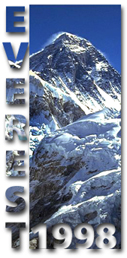
James Bruton, Telemedicine Communications Specialist
Dr. Vincent Grasso, Medical Director and Surgeon
Scott Hamilton, Expedition Director and Medical Technician
Dr. Kenneth Kamler, High Altitude Medical Expert and Surgeon
Dr. Christian Macedonia, Physician and 3-D Ultrasound Specialist
Edward Mattes, Logistics Specialist and Medical Technician
Rick Satava, Jr. Base Camp Manager and Medical Technician
The Yale University School of Medicine will be putting in place an advanced medical clinic at Base Camp to study physiology and tele-medicine in extreme environments. Dr. Vincent Grasso of Yale University will lead the medical team, with collaboration from high altitude specialist Dr. Ken Kamler: he was the doctor who treated Beck Weathers in '96. Jim Bruton is supervising the critical telecommunications necessary to allow telemedicine from Base Camp to Yale School of Medicine. A number of advanced technologies previously developed at the Defense Advanced Research Projects Agency (DARPA) and the US Army Medical Research and Material Command (MRMC) and the MIT Media Lab will be utilized to provide a high level of medical care. In addition, scientific investigation of high altitude affects with technology not previously available will extend our understanding of the human body beyond the incredible discoveries of previous expeditions. However it is the humanitarian endeavor which provides the proper perspective for the expedition.